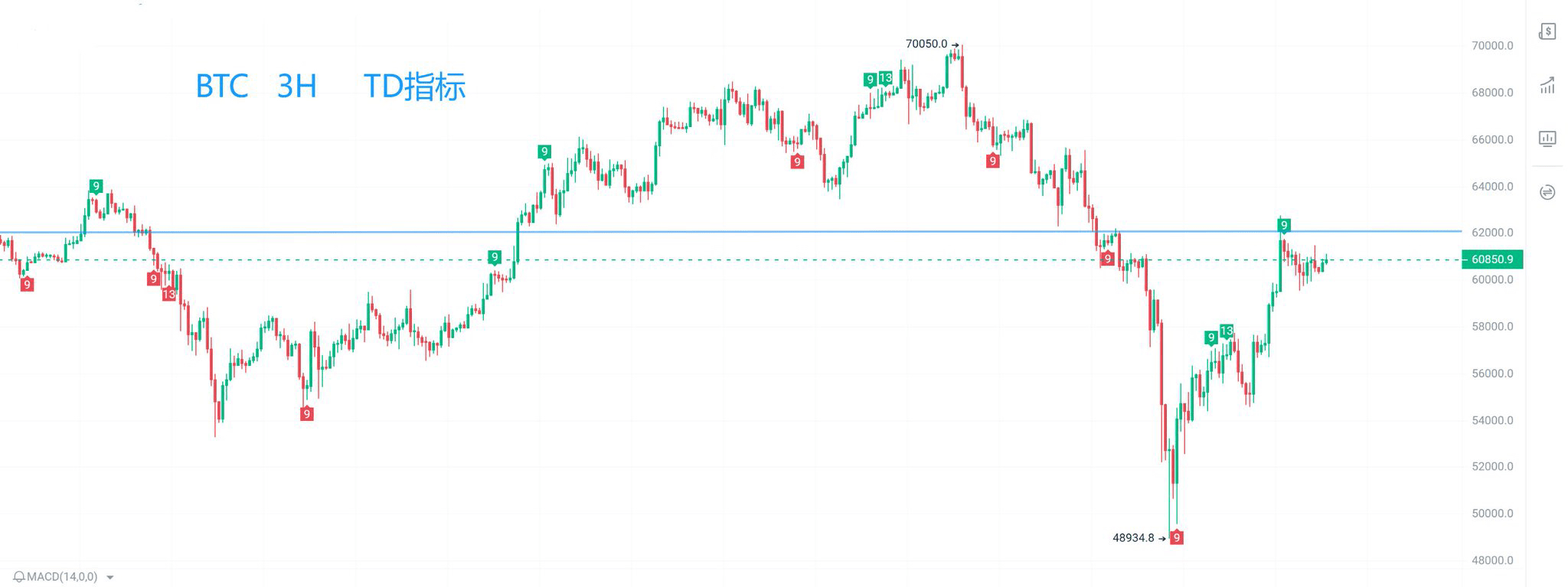TD is the abbreviation of Dimark Sequence. It is an indicator used to judge trend exhaustion and turning signals. It can also assist in judging oversold or oversold. In a specific market environment, it has a strong auxiliary reference value!
Its characteristic is to arrange the number of K-line runs in the order of 1 to 13 (it can be automatically presented by adding TD to the K-line chart indicator), among which "9" and "13" are two relatively important numbers, representing that there may be a turning point in this interval.
Everyone can find the application method of this indicator in the mainstream media, which is generally:
1. When "9" appears below the K-line, it means that the price may be oversold and there is a possibility of reversal upward. You can consider buying.
2. When "9" appears above the K-line, it means that the price may have risen too much and there is a possibility of a reversal and fall. You can consider selling.
When "13" appears, it means that the buy or sell signal is strengthened in the trend.
In actual combat, it is obviously not enough to just know these on the surface, because any indicator is only a reference. What is more important is that traders need to understand what kind of technical environment they are in so as to make more reasonable judgments.
Below, Tang Ge will talk about my personal understanding from the perspective of many troops based on my own practical experience:
The order of analyzing a coin is: 1. Trend ➡️2. Form ➡️3. Indicator. Then we will use this as a basis to expand on the long and short applications of the TD indicator in actual combat!
1. In a bullish trend, bulls often have accumulated sufficient energy. In the process of callback, in order to ensure the continuation of the trend, usually 7 small segments are used (5 to 9 are a reasonable range). If the first 5 are all negative lines (no positive lines or hanging neck lines), you can consider buying at the 6th to 7th time, and increase your position after 9 appears.
If the K-line is falling slowly with bullish patterns such as positive lines or hanging lines, you need to wait until 9 appears before buying.
2. In a volatile market, the market often has no obvious direction, and the reference role of TD is not great. It is only limited to use at a small level when the large-level K-line pattern is close to the upper and lower tracks of the oscillation range (refer to the first and third items for details).
3. In the bearish trend, the living environment of the bulls is relatively harsh and the selling volume is relatively large. You cannot use the first theory to participate in the rebound. At this time, you need to use the middle section of about 15 candles (12 to 18 candles are a reasonable range) as a reference for buying.
Generally speaking, if it contains large and medium Yinxian lines, you need to wait for the indicator to appear "9" and then buy when there is a K-line with a bottoming pattern; if it retraces in the form of small Yin or Yang, you need to wait for "13" to appear before considering going long.
Note: It is not recommended to use any single indicator as an absolute buy or sell signal. When three indicators appear at different points during the trading session, the winning rate will be greatly enhanced.
As a classic indicator in the trading market, TD naturally has its significance, but in actual practice it is necessary to coordinate the direction of the moving average and the shape of the K-line to comprehensively analyze the market.
The basic application of TD is mentioned in this article. More details need to be understood by traders in actual combat. If you have different opinions, please leave a message in the comment area.